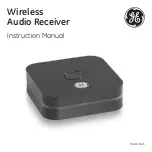
MDS 05-2415A01, Rev. A
FIELD TESTS & ADJUSTMENTS
4-11
3.
Using an oscilloscope set for DC coupling at 2 V or 5 V per division, observe the
Receiver Unsquelched (RUS) signal at Pin 10 of the
INTERFACE
connector.
4.
Insert an on-channel signal at –120 dBm (.225
µ
V), with a 1 kHz tone and 2.5 kHz
deviation. Adjust R41 fully counterclockwise while observing the oscilloscope
display.
5.
Set the squelch to be fully closed at this signal level by advancing R41 until the
oscilloscope pattern changes from about 8 V to 0 V. Watch for noise on the scope
display, and advance R41 slightly farther, if necessary, until the signal level remains
at about 0 V.
Transmitter Deviation
1.
Inject a test tone equivalent to the RTU audio output level (typically 1200 or
2200 Hz) into the radio at Pin 9 of the
INTERFACE
connector.
2.
Key the transmitter by entering
KEY
on the HHT, or by grounding the radio’s “not”
PTT line (Pin 16).
3.
Observe the deviation on the service monitor, and adjust it to 2.5 kHz using R168,
TX DEV.
R
M
If Remote Maintenance is installed, set R168 fully clockwise and use the
ID / DD / INCD / DECD
commands to adjust the deviation. The
ID / DD
com-
mands increment/decrement the deviation in single steps while the
INCD /
DECD
commands make larger jumps by adding a space and a number to the
command. (Example:
INCD_4
to increase the deviation by four steps out of
100.) When finished, type
RMST
to store the setting.
4.
Unkey the transmitter using the
DKEY
command.
5.
Close the Diagnostics Channel and disconnect the HHT from the transceiver.
Putting Things Back Together
1.
Reconnect feedline and interface cables to transceiver, and reinstall the cover.
2.
Confirm that the unit operates properly with the associated RTU. (Typically, the
transceiver should be transmitting intermittently in response to polling signals from
the master station.
3.
Secure all cables, providing strain relief if necessary, and check connectors for
tightness.
This completes the set-up of the MDS 4310 transceiver without a modem installed.
TEST PROCEDURE
➌
:
TRANSMIT FREQUENCY, SQUELCH, DEVIATION,
AND RECEIVE AUDIO OUTPUT—For Radios with MDS’s Internal 1200 BPS Modem
In the following procedures, references to SW1 & SW2 relate to the switches of the Data
Terminal Emulator (Figures 4-1). See Figure 4-2 for an assembly drawing of the 1200 baud
modem. See Figure 4-9 for the locations of adjustable controls on the transceiver mother–
board.
Continued on next page.
Summary of Contents for MDS 4310
Page 27: ...1 14 GENERAL MDS 05 2415A01 Rev A This page intentionally blank ...
Page 45: ...2 18 INSTALLATION MDS 05 2415A01 Rev A This page intentionally left blank ...
Page 61: ...3 16 PROGRAMMING AND DIAGNOSTICS MDS 05 2415A01 Rev A This page intentionally left blank ...
Page 85: ...4 24 FIELD TESTS ADJUSTMENTS MDS 05 2415A01 Rev A This page intentionally blank ...
Page 87: ......
Page 95: ......
Page 99: ...6 4 TROUBLESHOOTING MDS 05 2415A01 Rev A This page intentionally blank ...
Page 103: ...A 4 APPENDIX A MDS 05 2415A01 Rev A This page intentionally blank ...
Page 107: ...B 4 APPENDIX B MDS 05 2415A01 Rev A This page intentionally blank ...
Page 111: ...C 4 APPENDIX C MDS 05 2415A01 Rev A This page intentionally blank ...
Page 117: ......
Page 120: ......
Page 121: ...E 4 APPENDIX E MDS 05 2415A01 Rev A This page intentionally blank ...
Page 123: ...H 2 APPENDIX H MDS 05 2415A01 Rev A This page intentionally blank ...
Page 125: ...I 2 APPENDIX I MDS 05 2415A01 Rev A This page intentionally blank ...
Page 129: ......
















































